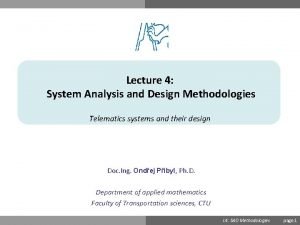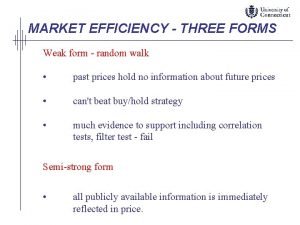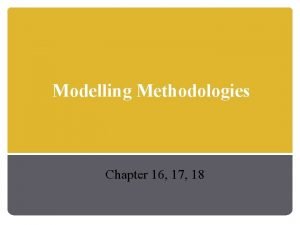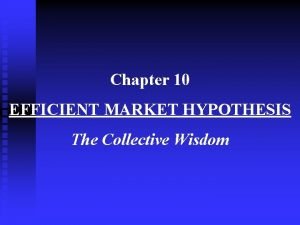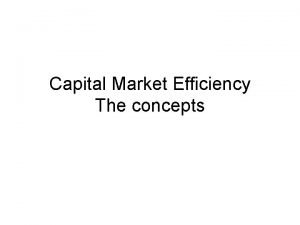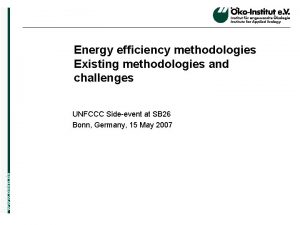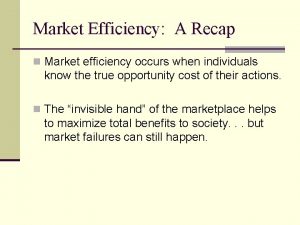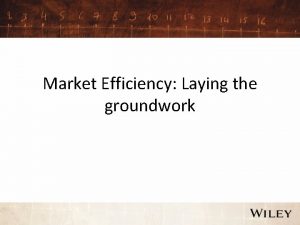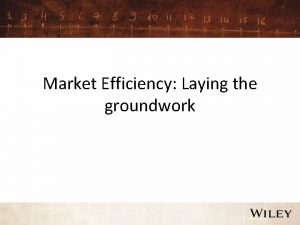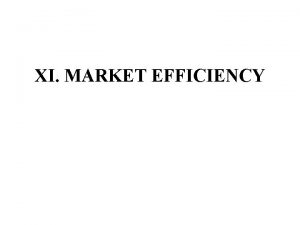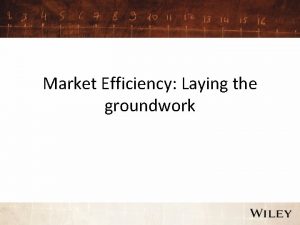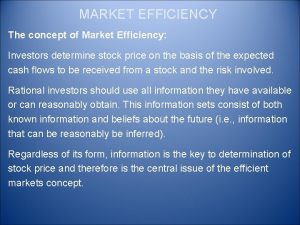Market Efficiency Chapter 5 Market Analysis Methodologies Forms















- Slides: 15

Market Efficiency Chapter 5 Market Analysis Methodologies Forms of Market Efficiency Testing Market Efficiency Technical Market Analysis Chapter #5 All Rights Reserved 1

Market Analysis Methodologies o Fundamental Analysis n n Evaluation of firms and their investment attractiveness Based on o o o firm’s financial strength competitiveness earnings outlook managerial strength Technical Analysis n n Chapter #5 Method of evaluating securities and forecasting future price changes Based largely on price and volume behavior All Rights Reserved 2

Market Efficiency o Efficient Market Hypothesis (EMH) n Security prices reflect all known information o o You cannot use past, present of inside information to consistently beat the market Three Forms of Efficiency n n n Chapter #5 Weak (historic prices) Semi-Strong (new information) Strong (inside information) All Rights Reserved 3

Weak Form Efficiency o o Past stock price return movements cannot be used to predict future price changes Implies technical analysis cannot consistently provide superior returns Chapter #5 All Rights Reserved 4

Semi-Strong Form Efficiency o o Market prices quickly and accurately reflect all public information Suggests fundamental analysis applied to publicly available information and data cannot systematically yield superior returns Chapter #5 All Rights Reserved 5

Strong Form Efficiency o o Market prices quickly and accurately reflect all public and nonpublic information Suggests even insider information will not consistently result in superior returns Chapter #5 All Rights Reserved 6

Random Walk Hypothesis o Stock prices wander about like a drunken monkey n Burton Malkiel’s “Random Walk Down Wall St” o o o n Chapter #5 You really don’t know where prices will be tomorrow Alternative Description: Brownian motion Best thing to do is buy and hold an efficient portfolio RWH consistent with EMT All Rights Reserved 7

A Partial Explanation for RWH o Some non-random observations… n n o Quarterly reports arrive at the beginning of the next quarter. Stock analysts tend to predict next [quarter] earnings on a regular basis What we don’t know… n n n Chapter #5 How will investors (& speculators) react news? Are positive reports necessarily good news? Why? Non-homogeneity of player expectations All Rights Reserved 8

Testing the Weak Form o Filter Rules (mostly statistics-based models) n n o Deviations exceeding plus or minus 2 s 5% Rule: price up or down more than 5% (Yale Rule) Fly in the Ointment n Serial Correlation o o o Price changes exhibit positive correlation over time Remove trends using first differences Markets tend to be weak form efficient Chapter #5 All Rights Reserved 9

Testing the Semi-Strong Form o Anomalies Literature n n n o Small firm effect January effect Low P/E effect Day-of-week effect (Friday-Monday) Listing on big board effect Being added to S&P 500 list effect Bottomline: markets not exactly semi-strong efficient Chapter #5 All Rights Reserved 10

Testing the Strong Form o SEC Rules notwithstanding… n n n Chapter #5 Insiders consistently earn abnormal risk adjusted returns A Research Artifact: insiders typically receive options that let them buy stocks at below market prices – locking in positive returns Insider buying is considered a positive sign. All Rights Reserved 11

Non-EMH Analysis o Technical Market Indicators n n n n Chapter #5 Sentiment Flow of Funds Contrarian Put-Call ratio Mutual Fund cash position Confidence indexes Short interest Moving Averages All Rights Reserved 12

Non-EMH Analysis o Charting n n n Chapter #5 Point and figure Candlesticks O-H-L-C Heads/Shoulders Resistance/Support (breakouts All Rights Reserved 13

Non-EMH Analysis o Some final words on Chartists n n Chapter #5 Believe that stock price movements occur in patterns consistent enough to be predictable Analysis indicates resistance and support levels Importance of volume – adds weight to trend Japanese futures market original source of candlestick method (12 -13 century CE) All Rights Reserved 14

Dow Theory o Market uptrend is confirmed if primary market index hits new high that is soon followed by high in secondary index n n o To make profit in stock market investors should take advantage of primary market trend n o Downtrend signaled in similar fashion Transports Index is favored confirmatory signal Whenever primary trend is up, each secondary trend will produce peak higher than last one – reverse true for down trend Any true indicator of primary market trend confirmed relatively quickly by similar action in different stock price averages Chapter #5 All Rights Reserved 15
 System analysis and design methodologies
System analysis and design methodologies Walk three forms
Walk three forms Opportunity cost formula
Opportunity cost formula Productively efficient vs allocatively efficient
Productively efficient vs allocatively efficient Allocative efficiency vs productive efficiency
Allocative efficiency vs productive efficiency Empirical approach
Empirical approach In which method regularity is used to reduce complexity
In which method regularity is used to reduce complexity Agile methodologies wiki
Agile methodologies wiki Define the relationship chapter 16
Define the relationship chapter 16 Task model
Task model Domain testing in software testing
Domain testing in software testing Indigenous methodologies
Indigenous methodologies Business performance management methodologies
Business performance management methodologies Methodologies for cross-domain data fusion: an overview
Methodologies for cross-domain data fusion: an overview Random walk efficient market hypothesis
Random walk efficient market hypothesis Capital market efficiency
Capital market efficiency
